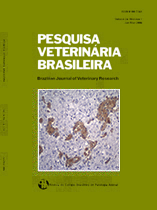 |
|
|
|
Year 2016 - Volume 36, Number 9
|

|
Morphology and histochemistry of accessory sex glands of Metachirus nudicaudatus, Didelphidae-Marsupialia, 36(9):881-892
|
ABSTRACT.- Costa S.F., Nogueira J.C., Zangeronimo M.G., Soares B.A., Chaves A.S. & Melo L.Q. 2016. [Morphology and histochemistry of accessory sex glands of Metachirus nudicaudatus, Didelphidae-Marsupialia.] Morfologia e histoquímica das glândulas sexuais acessórias de Metachirus nudicaudatus, Didelphidae-Marsupialia. Pesquisa Veterinária Brasileira 36(9):881-892. Departamento de Medicina Veterinária, Universidade Federal de Lavras, Campus Universitário, Lavras, MG 37200-000, Brazil. E-mail: sfcosta@dmv.ufla.br
This paper describes the morphology and distribution of glycogen and mucous substances in the prostate and the bulbourethral glands of Metachirus nudicaudatus (Geoffroy, 1803), the only species of the genus. The prostate is surrounded by the tunica adventitia, and muscle and stroma is formed by connective urethral mucosa. The glandular parenchyma consists of secretory tubules, scattered throughout the connective tissue of the urethral mucosa which differs histologically and histochemically in cranial, middle, and caudal segments of the prostate. These morpho-histochemical differences are also observed in the outer, middle and inner parts of the tubular epithelium of each prostatic segment. In general, prostatic segments secrete neutral mucous substances, and the caudal segment also produces glycogen. The three pairs of bulbourethral glands (lateral, intermediate and medial) are surrounded by a capsule of dense connective tissue and skeletal striated muscle. The glandular parenchyma is formed by tubules or branched tubuloacinar, covered by simple epithelium which is characteristic for each pair of glands. The lateral bulbourethral glands and the medial bulbourethral glands produce neutral mucous substances and the secretion of the intermediate bulbourethral glands consists of neutral mucous substances, carboxylated acids, and sulfated acids. The M. nudicaudatus does not have ampullary glands, seminal vesicles or coagulating glands. |
| |
|
|
| |
|
 |